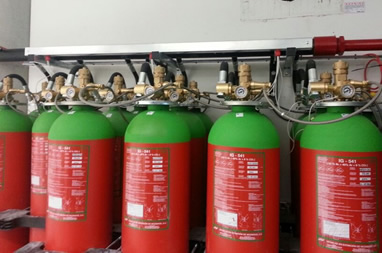
Gaseous Fire Protection
Inert gases are characterised by the fact that they do not take part in chemical reactions. Inert gases include: Helium, Neon, Argon, Krypton and Xenon. Certain other gases such as Nitrogen and CO2 behave like inert gases in a fire situation in that they also do not react as part of the combustion process.
The composition of the atmosphere consists of approximately:
| 78% by volume of Nitrogen | N2 |
| 20.9% by volume of Oxygen | O2 |
| 1% by volume of Argon | Ar |
| 0.03% by volume of Carbon Dioxide | CO2 |
Plus trace quantities of inert gases and particulate dust.
The composition of IG55 in each cylinder is:
| 45% to 55% vol of Nitrogen | N2 |
| 45% to 55% vol of Argon | Ar |
The composition of the IG55 & atmosphere mix will result in approximately:
| 70.1% by volume of Nitrogen N2 | N2 |
| 12.6% by volume of Oxygen O2 | O2 |
| 17% by volume of Argon | Ar |
| 0.03% by volume of Carbon Dioxide O2 | O2 |
Plus trace quantities of inert gases and particulate dust.
IG55 achieves its fire quenching effect by reducing the oxygen present in the atmosphere of a protected room space from 21% volume in air to approximately 12.5% volume. This is due to the Nitrogen and Argon displacing the normal air & some of the oxygen out of the room, subsequently leaving a mixture with more Argon in the room than previously (Refer to composition tables above). IG55 is discharged into the protected space at a flooding factor of 40 - 50% resulting in a minimum design concentration of around 37.8% after the 60 second discharge.
The high specific gravity of the Argon and the low specific gravity of Nitrogen when mixed have a combined specific gravity of 34 compared to specific gravity of air at 29. Thus the effect is to all but match the weight of the IG55 & room air mixture to the normal room air atmosphere.
IG55 fire fighting systems are designed to extinguish fires at the development stage and when compared with chemical agents such as FM200 or the now redundant Halon will sustain a fire suppressing oxygen level (approx 12.5%) over a long period within the protected room.
IG541
IG541 is a clean agent suitable for total flood applications as a Halon 1301 or Carbon Dioxide replacement.
IG541 is composed entirely of naturally occurring gases that are already present in the atmosphere; there are no environmental restrictions on its use.
IG541 has zero Ozone Depletion Potential (ODP), no Global Warming Potential (GWP) and no atmospheric lifetime. IG541 does not form decomposition products in a fire.
IG541 is stored as mixture of 52% Nitrogen, 40% Argon and 8% Carbon Dioxide.
IG541 is effective on all common types of fires (Class A, B and C).
Unlike Halon or Carbon Dioxide Systems, IG541 does not form a fog when it is discharged.
Therefore, exits remain fully visible. IG541 is stored as a gas, so there is no condensation or thermal shock when it is discharged into the protected area.
Because the final IG541/air mixture within a room has approximately the same density as air, suppression concentrations are held longer than traditional fire protection gases.
When released into a room, IG541 extinguishes fire by diluting the oxygen level to between 12% to 14%. Unlike any other inert agent IG541 contains a small amount of CO² to compensate for the reduction in the Oxygen level.